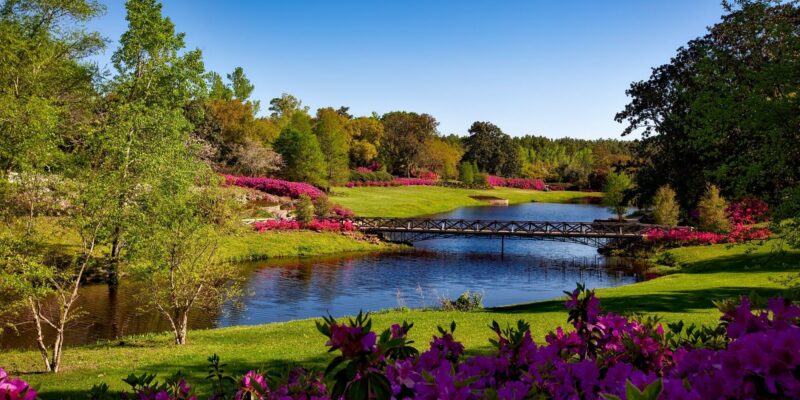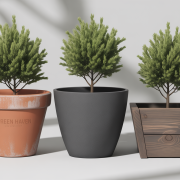The art of landscape design has evolved in recent years, with a newly revived emphasis on sustainability and low-maintenance practices. Today’s trendy outdoor spaces are more than just beautiful green plots; they’re also eco-friendly havens that require minimal care. Creating your ideal low-maintenance outdoor space can be an exciting adventure.
Along the way, you may need guidance, tips, or products to help you achieve your desired results. For instance, consider browsing the Golf Course Lawn Store for supplies that may assist you in maintaining a beautiful, well-kept lawn that reflects the high standards of golf course landscaping. Are you ready to transform your backyard into a serene sanctuary? Follow along as we guide you through the latest trends in modern landscaping that will make your outdoor space both gorgeous and low-maintenance.
Native Plants and Xeriscaping
Using native plants in your landscape design is not only eco-friendly but also significantly reduces maintenance. Native plants are well-adapted to local climate and soil conditions, making them more resistant to pests and disease. Additionally, they often require less water and fertilizers, and provide a natural habitat for local wildlife. Some popular native plants include wildflowers, grasses, shrubs, and various trees.
Xeriscaping is a landscaping technique developed specifically for areas prone to drought. It emphasizes water conservation through the use of drought-tolerant plants and efficient irrigation systems. Some key principles of xeriscaping include choosing the right plants for your climate, creating practical turf areas with low-water grasses, applying mulch to reduce evaporation, and implementing a drip irrigation system.
Surfaces and Materials
Permeable surfaces allow water to pass through the material, reducing runoff and preventing soil erosion. This environmentally friendly choice in landscape design not only helps conserve water but also adds visual interest to your backyard. Examples of permeable materials you can incorporate into your landscape design include pervious concrete, permeable pavers, gravel, and decomposed granite.
Using sustainable materials for your landscaping project not only benefits the environment but also often requires less maintenance. Choosing natural, recycled, or renewable materials adds aesthetic appeal and reduces waste. You can use materials like recycled plastic lumber, bamboo fencing, reclaimed wood, or recycled glass.
Saving Space and Water
Why limit your garden to the ground when you can take advantage of vertical space? Vertical gardens are an excellent low-maintenance choice for smaller outdoor spaces or for adding visual appeal to blank walls. They are also perfect for planting edible herbs, vegetables, and flowers without taking up precious ground space. Some popular vertical garden structures include trellises, green walls, and wall-mounted planters.
Smart irrigation systems conserve water and reduce the maintenance needed on your landscape. These high-tech systems use weather data and soil moisture sensors to determine when and how much water your plants need. This not only saves water but also ensures your plants remain healthy and lush all season long. Weather-based controllers, soil moisture sensors, and drip irrigation are all effective methods of irrigation.
Grass Alternatives
For those who desire a green lawn without constant watering and mowing, lawn alternatives can provide a low-maintenance, eco-friendly solution. Ground covers such as clover, moss, or creeping thyme can be an excellent replacement for traditional grasses, reducing the need for regular upkeep, while still offering a green and attractive space. These options can be visually appealing and conserve water, making them perfect for modern landscapes.
Hardscaping and Furniture
Incorporating hardscape elements into your landscape can create functional areas while reducing maintenance. Pathways, patios, and seating areas made of materials such as stone, pavers, or brick can create an inviting space for relaxation and entertainment. These hardscape features can also provide a visual balance to your landscape and make it more aesthetically pleasing.
To fully enjoy your low-maintenance landscape, choose outdoor furniture that is equally simple to care for. Look for materials that are weather-resistant, easy to clean, and durable. Some examples include aluminum, wrought iron, all-weather wicker, and teak. These materials typically require minimal maintenance and can withstand the test of time, allowing you to focus on enjoying your outdoor sanctuary.
Conclusion
Expertly designed low-maintenance landscapes are essential in today’s modern world. By incorporating some of these tips, you can achieve a serene sanctuary you’ll love without all the upkeep. These eco-friendly, low-maintenance designs not only enhance your outdoor living space but also ensure a better environment for future generations.













Comments